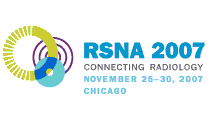
Abstract Archives of the RSNA, 2007
SSC20-01
Dobutamine Stress Cardiovascular MR Imaging in Patients after Coronary Revascularisation with Stent Placement
Scientific Papers
Presented on November 26, 2007
Presented as part of SSC20: Cardiac (MR)
Thomas Schlosser MD, PhD, Presenter: Nothing to Disclose
Fabian Meier, Abstract Co-Author: Nothing to Disclose
Oliver Bruder, Abstract Co-Author: Nothing to Disclose
Peter Hunold MD, Abstract Co-Author: Speaker, Bayer AG
Speaker, General Electric Company
Speaker, Guerbet
Speaker, Siemens AG
Joerg Barkhausen MD, Abstract Co-Author: Research Consultant, Bayer AG
We investigated the value of high-dose dobutamine stress MR imaging in CAD patients after percutaneous coronary interventions (PCI) for the detection of restenoses using invasive coronary angiography as the standard of reference.
50 Patients with known coronary artery disease who had undergone PCI with stent placement were examined with high-dose dobutamine stress MR imaging and invasive coronary angiography. MR imaging was performed on a 1.5 T MR scanner using a segmented steady state free precession sequence. All examinations were evaluated by an experienced radiologist and a cardiologist in consensus. Myocardial ischemia was defined by new or worsening stress-induced wall motion abnormalities in more than one myocardial segment.
In the 50 patients, coronary stents were placed in 74 coronary arteries. Seven in-stent stenoses were found by use of invasive coronary angiography; six of these cases were correctly diagnosed by MRI, one in-stent stenosis was missed by MRI which resulted in a sensitivity of 86%. Sixty-seven coronary arteries with implanted stents showed no significant stenoses in invasive coronary angiography, however, in seven of these vessels the MRI examination was false positive, which resulted in a specificity of 89%. The positive predictive value was 46%, the negative predictive value was 98%. Diagnostic accuracy was 89%.
High-dose dobutamine stress MRI allows for a reliable detection of significant in-stent stenoses.
Due to a high diagnostic accuracy the technique appears to be helpful in the selection of patients who need to undergo control invasive coronary angiography.
Schlosser, T,
Meier, F,
Bruder, O,
Hunold, P,
Barkhausen, J,
Dobutamine Stress Cardiovascular MR Imaging in Patients after Coronary Revascularisation with Stent Placement. Radiological Society of North America 2007 Scientific Assembly and Annual Meeting, November 25 - November 30, 2007 ,Chicago IL.
http://archive.rsna.org/2007/5015221.html

